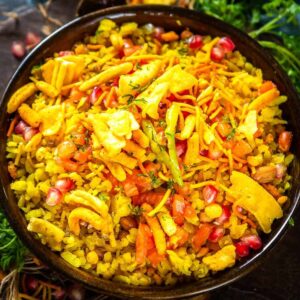Poha: (Recipe) A Culinary Journey
When it comes to Indian cuisine, there’s a delightful array of flavors and dishes that can tantalize your taste buds. One such dish that holds a special place in the hearts and palates of many is “Poha.” This simple yet delectable dish has a rich history and a unique blend of ingredients that make it a popular breakfast or snack option in India. In this article, we’ll take you on a culinary journey through the world of Poha, exploring its history, ingredients, preparation steps, and methods.

The Origins of Poha
To truly appreciate a dish, it helps to understand its origins. Poha, also known as “Pohe” in some regions, traces its roots to the Indian subcontinent, specifically to the western states of Maharashtra and Gujarat. While the exact timeline of its creation remains a bit hazy, it is believed to have been prepared for centuries.
Poha is deeply rooted in Indian culture and tradition. It is a dish that’s often associated with festivals, celebrations, and special occasions. In Maharashtra, it is a popular breakfast option, whereas in Gujarat, it’s often served as a part of the famous “Gujarati Thali,” showcasing its versatility and widespread appeal.
Ingredients: The Building Blocks of Poha
The beauty of Poha lies in its simplicity, both in terms of preparation and ingredients. The primary ingredient, of course, is flattened rice, locally known as “Poha.” These rice flakes come in various thicknesses, which can affect the final texture of the dish. Thin flakes result in a softer, more delicate Poha, while thicker flakes yield a slightly firmer texture.
Apart from Poha, you’ll need a handful of common ingredients:
1. Mustard Seeds: These tiny seeds add a burst of flavor and a subtle crunch to the dish. They are typically used for tempering in hot oil at the beginning of the cooking process.
2. Curry Leaves: These fragrant leaves lend an earthy aroma and a mild bitterness to the dish. They are usually added to the hot oil along with mustard seeds.
3. Green Chilies: For a touch of heat, you can add finely chopped green chilies. Adjust the quantity according to your spice tolerance.
4. Onions: Sliced onions bring a hint of sweetness and a satisfying crunch to the Poha.
5. Peas: Some variations of Poha include green peas, which provide a burst of color and a subtle sweetness.
6. Potatoes: Thinly sliced or cubed potatoes are a popular addition, making the dish more hearty and filling.
7. Turmeric: This spice not only imparts a beautiful golden color to the dish but also adds a warm, earthy flavor.
8. Lemon: A squeeze of fresh lemon juice adds a refreshing and tangy element that balances the dish’s flavors.
9. Fresh Coriander: Chopped fresh coriander leaves are used as a garnish, adding a burst of freshness and color to the finished dish.
Time to Shine: The Preparation Steps
Now that we’ve gathered our ingredients let’s dive into the preparation steps of this delightful dish. Poha is known for its quick and straightforward cooking process, making it a popular choice for busy mornings or when you’re craving a light yet flavorful snack.
Step 1: Rinse the Poha
- Begin by taking the required amount of Poha in a sieve or colander.
- Gently rinse it under running water for a few seconds. This step is crucial as it softens the Poha and removes excess starch.
- Allow it to sit and drain for about 10-15 minutes.
Step 2: Tempering
- Heat a few tablespoons of oil in a pan or kadai over medium heat.
- Add mustard seeds and let them splutter.
- Toss in some curry leaves and chopped green chilies. Sauté for a minute or until fragrant.
Step 3: Adding Onions and Potatoes
- Add sliced onions and sauté until they turn translucent.
- If you’re using potatoes, add them at this stage and cook until they are slightly tender.
Step 4: Spicing It Up
- Sprinkle some turmeric powder over the mixture and give it a quick stir. This imparts a lovely color to the dish.
Step 5: Incorporating the Poha
- Now, gently add the drained Poha to the pan.
- Stir everything together to ensure the Poha is well-coated with the turmeric-infused oil.
Step 6: Peas and Seasoning
- If you’re using peas, toss them in at this stage.
- Season the mixture with salt and a pinch of sugar for balance. Mix well.
Step 7: Steam and Cover
- Reduce the heat to low and cover the pan with a lid. Allow it to steam for 5-7 minutes, or until the Poha softens and absorbs the flavors.
Step 8: The Final Touch
- Finish off by squeezing fresh lemon juice over the Poha. This not only enhances the taste but also brings a touch of freshness.
- Garnish with freshly chopped coriander leaves.
Serving and Variations
Poha can be enjoyed hot and fresh, straight from the pan. It’s often served with a side of coconut chutney, yogurt, or even a sprinkling of sev (crunchy chickpea flour noodles) for added texture and flavor.
One of the fascinating aspects of Poha is its adaptability. Depending on the region and personal preferences, there are numerous variations of this dish. For instance:
1. Kanda Poha: This version is popular in Maharashtra and includes onions, mustard seeds, and curry leaves for a simple yet flavorful dish.
2. Batata Poha: A heartier version from Maharashtra, it includes potatoes, giving the dish more substance.
3. Indori Poha: A specialty from Indore, this variation is known for its spicy and tangy flavors, with the addition of fennel seeds, peanuts, and pomegranate seeds.
4. Gujarati Poha: The Gujarati version includes a touch of sweetness with the addition of sugar, along with mustard seeds, cumin seeds, and peanuts.
In Conclusion: Poha, a Culinary Gem
Poha is not just a dish; it’s a comforting and flavorful experience that connects us to the rich tapestry of Indian culture and cuisine. Its humble yet delicious ingredients, quick preparation, and adaptability make it a beloved choice for breakfast, brunch, or even a light dinner. Whether you savor it in the bustling streets of Mumbai or prepare it in the comfort of your home, Poha is a dish that brings people together through its enticing aroma and delightful taste. So, the next time you’re in the mood for a taste of India, give Poha a try and embark on a culinary journey that’s both simple and extraordinary.
Poha recipe(youtube)- https://www.youtube.com/watch?v=VKvwWeVy8Nw

